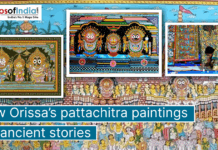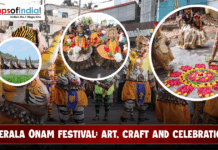One of India’s salient aspects is its rich culture, which shimmers with traditional art forms and a myriad of unique historical craftwork. Kalamkari is a captivating art form with detailed patterns and elaborate narratives within that frame. Kalam painted on fabric is a type of Kalamkari art. However, Kalamkari is also practised on palm leaves in Srikalahasti, Andhra Pradesh. The intricate patterns drawn by these artists show the beautiful and lively figures of various creatures, natural beauty, and stories that bring meaning to the work of art.
The Origins of Kalamkari
Kalamkari is derived from the Persian words: ‘kalam‘ (pen) and ‘KARI‘ (craftsmanship), which means ‘painting pen style.‘ It is a more than 3000-year-old art form, and Indian literature generally refers to it when discussing it. Pictorial epic notations of any religion, be it the Ramayana, Mahabharata, or the Puranas, into which many great events or characters are to be pictorialists, made extensive use of Kalamkari and became one of the most important media involved.
Kalamkari is of two types:
Machilipatnam Kalamkari: A Kalamkari carved through the block-print method.
Srikalahasti Kalamkari: Hand-painted in freehand drawings, done entirely by human effort.
Temple-town Srikalahasti art, which is used in much divine worship, influences temple hangings and chariot banners.
A significant feature of this art style, Srikalahasti, also affects the temple’s environmental surroundings: its hangings and chariot banners.
Kalamkari on Palm Leaves: Eco-Friendly Revived in the Textile
Before the advent of paper and other modern fibres, the Indigenous people of India wrote and painted their stories with the help of palm leaves (Coleoptera). They used them to ink down the tablets of knowledge, sciences, and other scriptures. The palm-leaf manuscripts proliferated throughout South India and different zones, with their scope spreading from religious scriptures to storied folklore and finally to medical sciences. This ingenious fusion of Kalamkari style and palm-leaf art means the virtuoso artists from Srikalahasti have breathed new life into this art form by crafting nature-friendly products that promise timelessness and beauty.
The Process of Creating Kalamkari on Palm Leaves
-
Selecting and Preparing the Palm Leaves
Mature palm leaves are preferred because their fibres are more pest-resistant than young palm leaves. The leaf is peeled off the stalk, dried, and flattened to make a smooth paper. If the palm leaf is unavailable, the strips are cut according to their size and stitched together.
-
Drawing the Design
The artists might use simple bamboo or date palm sticks to create ornaments. The pictures are strongly oriented toward Hindu deities, with a natural aspect and mythical styles. Unlike the cloth Kalamkari, where the tribal hold the brush and paint, the palm leaves demand more precision, as they are highly textured.
-
Preparation of Natural Dyes
One of the salient features of the Kalamkari technique is its natural dye applications. Colour preparations are made through:
Black: Iron acetate (jaggery/iron nail mix)
Red: Varieties of madder root/alum or root treatment
Yellow: Pomegranate skins or turmeric
Blue: Vat-dyeing of indigo
Green: Yellow plus blue.
-
Painting and Detailing
Using a special fine-tipped bamboo pen (kalam), the artist picks up the needed colours and gently lands them on the layers.
Having a tight grip for every stroke is also necessary because the palm leaves demand more control than the cloth.
The colour is naturally drawn in, which appears feathery and “faintness in the air.”
-
Preservation
The leaf is diligently saturated with natural oils on both sides to keep a stiff and flat shape.
Beeswax is a natural product that artists also find helpful as an additive, not just for better durability but also for a better sheen.
Themes and Symbolism in Palm-Leaf Kalamkari
Gods and goddesses (Hindu) are often imagined and depicted in Kalamkari’s palm leaf art, and here are a few ways to plant this thought in your mind.
Hindu Gods and Goddesses: Lord Krishna isn’t the only important rendition of the leaf (palm); Goddess Lakshmi and Lord Ganesha are also important.
Mythological Scenes: The intricate depiction in the palm leaf offers scenes from the Ramayana, such as Ravana’s defeat or Hanuman’s devotion.
Floral and Fauna: The peacock was originally a natural representation, symbolizing fertility and prosperity, while lotus flowers and vines were connected with divinity.
Tribal and Folk Art Influences: The pieces often include sketches, Gond, and Wari art forms.
The Challenges Faced by Srikalahasti’s Palm-Leaf Artists
The composition might be beautiful, but some challenges can be faced by it:
Declining Demand: Nowadays, consumers are more interested in cheap and readily available mass-produced items than handmade and artistic palm-leaf decors.
Scarcity of Skilled Artisans: The falling rate of artisan skills development and their passing without training others is dangerous to unique cultural industries like this.
Environmental Factors: Palm leaves are prone to moisture and pests, so they must be stored properly. They lack a clear will and structure to be harvested or cultivated.
Economic Struggles: Most artisans suffer from poverty due to the exploitation of intermediaries, who pay them very little for their work.
Efforts to Preserve and Promote the Art
Such organizations and individuals aim to support the longevity and vitality of palm leaf Kalamari:
Government and NGO Support: Measures like ‘Hunar Hata‘ and ‘Indian Craft Council’ provide means for designer artists.
Workshops and Exhibitions: The artists attract the world with their work through live demonstrations at cultural festivals.
Eco-Friendly Appeal: The increasing use of sustainable things has seen the demand for palm-leaf Kalamkari as a touted green alternative to artificial decor.
Online Marketplaces: Websites like Amazon Handmade, Etsy, and Jeypore efficiently spread the product internationally by directly connecting the craftspeople and online buyers.
Why Kalamkari on Palm Leaves Deserves Global Recognition
This art form is not just an art form; it is a unique living heritage, summarizing:
Sustainability: It is a given that natural fibers like palm (coconut) leaves are renewable and decompose without hazard. These fibers grow abundantly in the natural tropical environment.
Cultural Continuity: It keeps the older forms of storytelling alive in a brand-national state. It provides a new experience for the viewer, keeping the story intact and revealed.
Artistic Mastery: The level of artistry involved is the need to make it absorb the paints, etc. This technique is one of the best, and India is so proud.
The tradition ‘Kalamkari on Palm Leaves‘ of Srikalahasti is a valuable museum piece in the vast collection of Indian culture, which unites the holy and the environment on the same fabric. Among the contemporary obstacles that focus on the activity, the passion of these artisans ensures that this centuries-old tradition continues to endure. Any of us should be willing to go the extra mile to see these artists thrive and keep alive this age-old tradition that will be around for long, just like the swaying palm leaves in the breeze despite the tales they stay alive.
Whether you are an art enthusiast or a cultural connoisseur, patrons of creating palm-leaf Kalamkari could be, for instance, more than just an acquisition. They are the divine experience of celebrating India’s ancient and cultural legacy.




